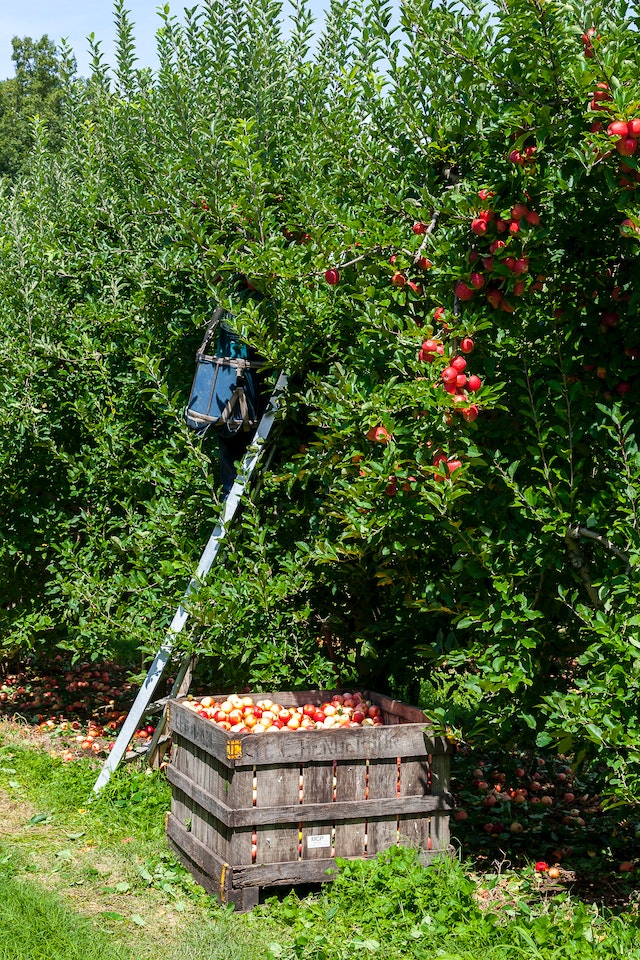Taking a holistic view of growing fruit trees can save you time. Many of the things you do to your fruit garden are interrelated; as you take one action you may save yourself another. So, observe, explore, keep a few notes, and don’t be afraid to try something different if what you are currently doing is not bringing the expected results. Above all relax, be patient, and enjoy! Most fruit trees are quite resilient and will allow you to make a few “mistakes” along the way. Consider them learning experiences and don’t worry; most fruit trees will bounce back. Although there is much to be learned, it certainly doesn’t all need to be done at once. Start small with one or two of the easily grown trees. By the time they are bearing fruit you may find that you have a much greener thumb than you ever envisioned. Yes, growing fruit trees is fun and not all that difficult. Let’s take a look now at the many ways that you can enjoy fruit trees in your landscape.
Getting Started With Fruit Trees
This is an excerpt from the Book Called “The Backyard Orchardist” Continue reading to learn more about Getting Started With Fruit Trees, thanks to the author.

Enjoying Fruit Trees In Your Landscape
The lore and love of fruit trees has been with us for many generations. Johnny Appleseed, pioneer of apple orchards, has long been a folk hero and George Washington brought the cherry tree to fame with his famous “I cannot tell a lie” declaration. For many gardeners the attraction of growing a fruit tree is as strong today as it was during the days of these well-known figures. Yet, many gardeners today are concerned that they lack the hands-on experience, space, or time needed for fruit growing.
The wonderful thing about fruit trees is that they can be enjoyed by virtually anyone willing to invest a little bit of energy and patience into growing them and they can be enjoyed in so many different ways. Whether you are a novice gardener who would like to start a new adventure or a seasoned veteran looking for something unique, fruit trees are rewarding, interesting and relatively simple to maintain once you understand some basics. To introduce you to this exciting hobby, The Backyard Orchardist will explore the essential concepts of fruit growing, guide you through the skills needed to successfully care for your own fruit trees and, literally, encourage you to enjoy the fruits of your labor.
One of the first things you will learn is that fruit growing is an avocation that takes a little bit of forethought and patience. For practicing these virtues you will be well rewarded, however. You will have the pride of saying “I grew it myself” and the opportunity to enjoy the sweetness and flavor that only tree-ripened fruit offers. You will also become privy to the art and science that is behind the mystique of fruit growing. The Backyard Orchardist is meant to be an encouraging hand and personal consultant throughout the adventures of fruit growing. You will soon find out that fruit growing is both a science and an art. As you begin your adventure with fruit trees, you may want to read through The Backyard Orchardist completely land then return to those chapters most pertinent to your current needs.

Fruit Trees For Self-Sufficiency
With uncertainty and turmoil so often being the headline of the daily news, many people today are looking to their gardens for a sense of security and self-sufficiency. By producing, processing, and storing food from your home garden, you can reduce the effect of rising grocery store prices_ much of which is driven by marketing and transportation costs rather than actual improvements in food quality.
Growing fruit trees brings a great deal of pride, along with feelings of success and self-sufficiency. Being able to share the fruits of your labor with friends and family while saying, “I grew it myself,” can be as rewarding as the joy of knowing that you have learned new skills in the process.
Control Over Food Safety And Environmental Stewardship
Increasingly, people are becoming aware and concerned about how and where their food is being grown. Many are concerned about crop protection methods and food safety practices. Backyard fruit growing offers you better control over the environmental impacts of food production and its effect on our own health. Including fruit trees in your garden allows you to have first-hand control in the decisions on how your food is raised, eliminates the negative effects of long distance transportation, and it may provide you with the ultimate in unique and locally available varieties.

Personal Enjoyment
Most gardeners consider feeling the sun on their backs and the soil in their hands pleasure in itself. Much satisfaction comes from nurturing a plant while enjoying the outdoors. Many are the rewards of watching the fruit tree grow and change with the seasons, knowing that you played a part in its development.
Health and Nutrition Benefits
Everywhere we read about the benefits of more exercise and the need to eat more fruit and vegetables for the fiber and naturally occurring vitamins they contain. By planting fruit trees in your yard, you are on your way to incorporating both of these healthy practices into your lifestyle almost effortlessly. The regular care that fruit trees require will give you a pleasant way to relax, work a bit of exercise into your routine throughout the year, and the fruit you enjoy from your harvest will be a benefit to your diet. Helping raise and enjoying garden-fresh fruit encourages and makes it easy for children to develop healthy habits early in life.

Visual Beauty
Long before your fruit tree provides you with delights of the palate, it will delight the eye. The apple tree’s light pink bloom turning to delicate white is a sight to behold. An apricot, peach, or nectarine tree with its profuse pink bloom can be a showpiece in your yard. For a real conversation piece, consider an espalier pear tree. You can use a single fruit tree to direct the eye to a focal point in your landscape or a collection of trees to fill a void in your yard or screen out an unsightly vista beyond. .
A Bountiful Harvest
High on most people’s list of reasons for wanting to grow fruit trees is the enjoyment they get from the fruit itself. There are many ways to enjoy your harvest. Growing your own fruit offers you access to uncommon fruits as well as your favorite varieties. This may be especially important if you yearn for a particular “old-fashioned” variety such as one you might remember from grandpa’s farm.
Preservation of Heirloom Varieties
Many of the older, or antique, varieties are not being raised commercially today for a number of reasons. By today’s market standards, many have a less than perfect appearance, a short storage life, or a tendency to bruise easily that makes them unsuitable for long-distance shipping. Since you are not likely to be selling your harvest, you won’t need to be concerned with these commercial limitations. Instead, you can concentrate on enjoying what these old-time fruit varieties have to offer_ flavor! Many antique varieties have unique flavors that are hard to find on today’s grocery shelf. Fruit is sweetest and juiciest when picked fully ripe, but at the point it is too perishable to ship to distant markets. Plums and peaches are particularly flavorful, but only the home orchardist has the benefit of enjoying them at their peak. Aside from eating fruit fresh, you will also be able to preserve it for use in the off-season. Many of the antique varieties are particularly suited to drying, canning, freezing, or preserving in all sorts of wonderful jams, jellies, and chutneys.

As a Climate Modifier
Properly placed, fruit trees can be used to create small areas of shade to shield a large window from the sun during the warmest times of day or shelter a picnic table for a cool summer meal. In windy areas, several fruit trees planted close together can act as a natural windbreak to protect your home from winter winds and help keep your heat bill down. A hedgerow of fruit trees can also be useful as a sound-muffling barrier if you need protection from noisy neighbors or a busy street.
As Wildlife Habitat
For many people, a most enjoyable activity is watching the birds that come to their window feeders. Fruit trees can serve as a protective area for shy bird species while they work up the courage to visit your feeder and as nesting places throughout the season. Placing a tree within viewing distance can often allow you to enjoy the sight of a flock of cedar waxwings in late winter or numerous grosbeaks. Both species enjoy eating any leftover apples that may hang from a tree and can be easily encouraged if a share of the crop is left for them. Inviting birds to your yard will also give you the benefit of their appetite for numerous insects and help reduce the population of pests that may bother humans or your fruit crops.


